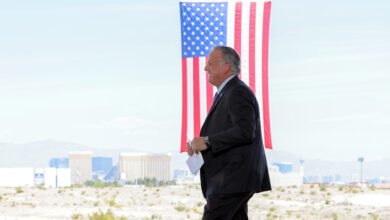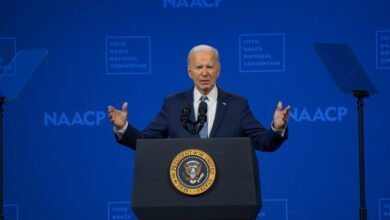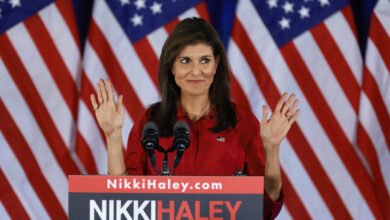Emotions are what sells • Nevada Current

We are officially in yet another make-or-break election year for democracy. Already it feels like the ticking of a doomsday clock.
The data points are strange and bleak. A Times/Sienna poll last fall showed President Biden getting beat handily by Donald Trump in five of six crucial swing states. Despite Trump’s utter disregard for the lives of Palestinians during his time in office, a majority of young voters say Trump would do a better job of dealing with the conflict in Gaza. Neither do the 91 criminal indictments seem to put a dent in the Trumpian armor.
There is no rational explanation for this. Not when a second Trump presidency is likely to be an abandon-all-hope-and-run-for-the-exits scenario. And even then, where would you go in a world carved up by Putin, Xi Jinping and the darkly authoritarian America promised by Trump? The cruel global dystopia that science fiction authors have long described might be just around the corner.
But if the trends in public opinion aren’t rational, then what? As is true of candidates, political issues and favorite consumer products, emotions — often unconscious — are shaping attitudes. That would explain why the president’s logical political arguments — the economic winds are mild, we’ve made huge investments in fixing the climate, we brought back some normalcy after taking over during a pandemic — aren’t working. I’m beginning to think the problem is a lot like the “deaths of despair” geographers attribute to isolation, addiction and suicide in our communities, only writ large across the whole exhausted socio-political culture.
A great American death of despair, which is pushing them toward the possibility of a nihilistic Trump second term.
So how do you talk voters off the ledge? A smart political strategy must address the underlying emotions at play. Or, vibes, as we call it these days.
As an ad guy, that’s my discipline. Here are a few thoughts on how that might work.
First, think about how the parties themselves contribute to the negativity afflicting so many voters. Democrats tend to run on big promises, which can never really be fulfilled to the extent voters expect. Republicans run on dissatisfaction, which will always be in abundant supply. Add those together and you get a negative feedback loop that amplifies voter frustration. You’re always at a political disadvantage trying to argue your way out of it.
Second, think about what success looks like: Winning a relatively small number of voters on the margins. We live in a sharply divided nation. You don’t need to win all the arguments or persuade all the voters, as satisfying as that might feel. You succeed by creating enough emotional differentiation to give your side an edge.
A way to answer both of these is to engage voters now, well ahead of the election. Republicans do a good job of engagement, but only with the limited group of people in the MAGA base. They’ll always have to depend on amping up dissatisfaction to get the larger numbers needed to win an election.
The opportunity to do something truly creative and unexpected lies with the Democrats. A majority of voters, especially the younger ones who could swing elections in 2024, are not likely to engage with the party, or any institution for that matter. They’re disenchanted by candidates, distrust institutions and are frustrated by the issues. What they might respond to is a political brand that talks about re-engaging with America.
I don’t mean the big marble-pillared institutional idea of America. I’m talking about the “us” that America represents. The communities and the big ideals they represent. The potential to work together for good. At its best America is an essentially progressive idea. It’s not hard to connect that with the core values that younger voters often say is their primary motivation. Use big American symbols and language to strengthen the social ties that have been broken by the pandemic and negative polarization. Create the larger sense of belonging people say they’re looking for — and we know they’re wired for as humans. Involve people in finding answers, even if that only means challenging them to do some learning about the issue.
Engagement has become one of our more effective tools in consumer advertising. Engagement leads to persuasion because even when it’s small — like a response on social media — there’s an emotional investment. You can build a strategy around a message that emotionally connects and inspires small acts of engagement.
It works the same way in political campaigns. Consider the two most famous political ads in history: Lyndon Johnson’s “Daisy” ad in 1964, which used fear of nuclear annihilation to turn voters away from the scary-seeming Barry Goldwater. And Ronald Reagan’s “Morning in America” ad in 1984, which employed warm feelings of hope and renewal.
Aside from Johnson’s brief voiceover, neither ad featured the candidate.
In a little remembered bit of historical trivia, Hal Riney, who wrote the “Morning in America” ad, argued against including Reagan because he thought the candidate’s poll numbers, which at the time hadn’t recovered following the 1982 recession, made him a liability.
Nor are the ads recitations of the finer points of the policies of Johnson and Reagan. They are emotional appeals.
Researchers have studied messages that either anger, scare or move people, as in the example of these two venerable ads. Both can be highly effective, especially in motivating people to support candidates and parties they already identify with. This election year is hard, given the fragmented nature of our media and the severe lack of enthusiasm for both parties and their candidates.
That’s why I think the first party that finds a way to create engagement with our larger, better sense of America is the one that wins.
A good start is the old John F. Kennedy formulation. “Ask not what your country can do for you, ask what you can do for your country.” There’s a reason why merely watching a clip of that speech — or hearing a particularly moving version of the “Star Spangled Banner” or “This Land Is Your Land” — can light up the brain’s limbic system for many people.
Updated for 2024 it might be, “Stand with America, we have work to do together.” That’s a thought you can make work in your own words if you’re running for national office.
It can work nationally or if you’re thinking about a run for a state House seat in a rural Minnesota district, like a friend of mine is. It also works if you’re looking for a more effective way to confront the trolls on your social media feed, but that’s an ancillary benefit.
An emotional appeal to our better angels, as Lincoln would put it, might be just the thing we need to swing the momentum in a more hopeful direction during this confounding, frightening election year.
This column was originally published in the Minnesota Reformer.





